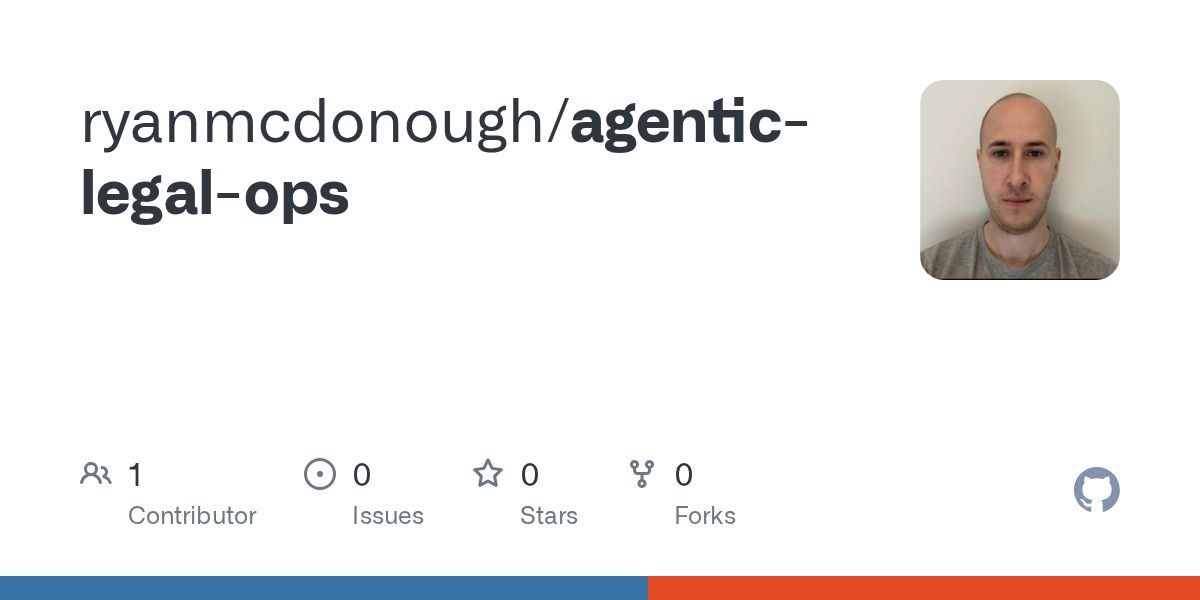Agentic LegalOps: A Glimpse into Autonomous Document Review

Legal teams spend a surprising amount of time moving work around, deciding who should review a document, whether something needs escalation, or if a clause breaks policy. It’s routine, manual, and almost always based on rules everyone already knows.
So I built a simple proof of concept to show what happens when you start making that logic explicit.
This isn’t legal advice, and I’m not a lawyer. It’s a small demo designed to show what becomes possible when firms codify their knowledge like the workflows, risk logic, and approval rules that already exist and connect that data to systems like document management, case management, and HR.
The Concept in Action
The demo acts as an intelligent router for contract changes. When a user edits a document, the system analyses the change, checks the risk profile of the clause, and decides who should review it next.
Each decision takes into account:
- Clause risk level: low, medium, high, or critical
- User experience: junior, senior, or partner
- Value or materiality: low-value NDAs vs multimillion-pound contracts
- Policy deviation: whether the change moves away from approved wording
If a junior edits a high-risk indemnity clause, it escalates to a partner. If a senior adjusts a low-risk confidentiality term, it’s cleared automatically. Every outcome is justified with a reasoning trace that shows why the decision was made.
The Building Blocks
- Mock Document Management System (DMS)
Simulates how a real platform detects edits and versions. - Clause Risk Registry (CRR)
A simple database mapping clauses to risk, escalation, and policy guidance. - Agent Router
A local LLM (via Ollama) that uses the CRR data, user role, and policy metadata to make routing decisions. - User Interface
Lets users test real-time scenarios and see exactly how the system reasons through each one.
Everything runs locally. No external API calls, no data exposure.
Making It Real
The technology isn’t the hard part (it never usually is....), it’s the preparation. For this kind of autonomy to work, firms need to start documenting what’s currently implicit.
Here’s what that looks like in practice:
1. Codify the “Unwritten”
Write down how work actually moves: who reviews what, when escalation happens, and what counts as high value. These are usually team rules passed around verbally. Once they’re codified, they become machine-readable and repeatable.
2. Structure Policy Data
Most risk or drafting policies are written in prose. Machines struggle with that. The goal isn’t to rewrite them, just to add structure:
- Tag clauses by risk or department
- Extract thresholds (£1m+ requires partner review)
- Identify approved wordings vs prohibited ones
Even a lightweight JSON file or tagged document library can become a foundation for automation.
3. Link Your Systems
Connect case management (for matter data), document management (for versions), HR or Active Directory (for experience levels), and knowledge repositories (for policy and precedent data). The magic comes from those links, not from the AI itself.
4. Design for Transparency
Every autonomous decision must be traceable: what inputs it used, what rules it followed, and what reasoning it gave. Without that, the automation is just guesswork.
The Routing Logic
| Role | Typical Autonomy | Escalation Example |
|---|---|---|
| Junior Associate (<2 years) | Must escalate all edits | Even low-risk NDAs sent to senior or partner for sign-off |
| Senior Associate (2–6 years) | Can self-approve low-risk or low-value work | Escalate to partner for medium+ risk or value > £1m |
| Partner (6+ years) | Oversight only | Notified for audit or policy deviation |
Risk levels follow standard categories, say indemnities, liability caps, and regulatory clauses always trigger partner oversight, while definitions and governing law stay low risk.
Why Local Matters
The demo runs entirely on a local model. That means no data leaves the environment, every reasoning step is visible, and all decisions are auditable. It’s not about outsourcing judgement; it’s about embedding accountability directly into the system.
That’s where agentic systems start to make sense for legal work: not in abstract autonomy, but in controllable, explainable workflows that reflect how firms already operate.
What This Means for Legal Teams
The firms that benefit most from automation won’t be the ones with the fanciest AI models. They’ll be the ones that have done the groundwork:
- Their policies are structured.
- Their workflows are documented.
- Their data is connected.
That’s when an autonomous system can make smart, defensible choices without human intervention because it’s built on rules humans actually agree on.
The Technical Core: How the System Actually Works
For anyone curious about what’s happening under the hood, the proof of concept isn’t a slide deck or a full mock-up, it’s a functioning architecture built to show what’s already feasible with the tools most teams have today.
It runs on a lightweight, modular setup with four key components working together:
- Document Management System (DMS): tracks versions and detects clause-level changes.
- Clause Risk Registry (CRR): assigns risk levels, flags policy breaches, and determines escalation paths.
- Agent Router: the decision-making layer, powered by a local large language model.
- Dashboard: a simple interface for reviewing decisions and tracing how they were made.
At this stage, each of these is a mocked service, deliberately simplified so you can see the logic in motion. The idea is that any of them could be swapped out for real systems: an iManage or HighQ DMS, a firm’s internal risk registry, or an HR data source. The architecture already supports it. The point is to demonstrate that none of this is futuristic. It’s all achievable with existing tech.
Here’s the flow. When someone edits a contract, the DMS triggers a change event and sends it to the CRR, which enriches it with risk data and policy metadata. That enriched data goes to the Agent Router, where a local reasoning model analyses the change in context then considering the user’s role, experience, and previous exposure to similar contracts and determines whether the change can pass, needs peer review, or should be escalated.
It’s all built using FastAPI with async processing and an entirely stateless design. The LLM layer can run either through OpenAI’s API or locally via Ollama, using models like phi-3 or llama-3.1, depending on performance and privacy needs.
The model isn’t just executing fixed logic. It reasons over structured inputs that include the user’s profile, the nature of the change, and firm-defined routing heuristics. It then returns a JSON decision explaining what should happen next and why, complete with an audit trail. If the model goes offline, the system automatically falls back to rule-based routing, so the workflow continues uninterrupted.
What this proves is that intelligent routing doesn’t require new infrastructure, huge budgets, or experimental tech. It just needs existing systems to start talking to each other in a structured, explainable way.
This prototype isn’t the destination, far from it. It’s hopefully a sign for people that the next wave of legal automation will rely less on smarter models and more on better data foundations.
If your risk, policy, and process knowledge only exists in PDFs and people’s heads, there’s nothing for an agent to act on.
The future of legal ops isn’t about teaching AI to think like lawyers. It’s about helping firms describe their thinking clearly enough that AI can support it.

